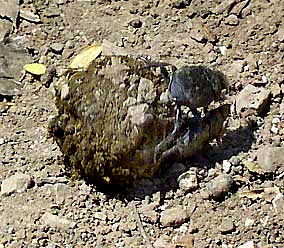Excerpts from Jim Conrad's
Naturalist Newsletter
from the April 21, 2007 Newsletter issued from Sierra Gorda Biosphere Reserve, QUERÉTARO, MÉXICO
FIVE TUMBLEBUGS IN A ROW
 I think more cows and burros use the trail from Cocos to the valley floor than people, for there was plenty of manure on it, fresh and dried-out. One pile was so fresh that tumblebugs were still working on it. I got down on my belly and took the best picture I could of one, though my camera isn't much for close-ups. You can see a manure-encrusted tumblebug (on the ball's right) using his hind legs to push the ball up the trail at the right.
I think more cows and burros use the trail from Cocos to the valley floor than people, for there was plenty of manure on it, fresh and dried-out. One pile was so fresh that tumblebugs were still working on it. I got down on my belly and took the best picture I could of one, though my camera isn't much for close-ups. You can see a manure-encrusted tumblebug (on the ball's right) using his hind legs to push the ball up the trail at the right.
Tumblebugs are scarab beetles -- members of the insect family Scarabaeidae. The ones I've seen have all been thick-bodied, black beetles. When they find poop they mold it into balls, roll the balls away and bury them for future eating or maybe for laying their eggs in. When the eggs hatch, the kids find themselves surrounded by food. Lots of tumblebug species exist, and some specialize in tumbling pre-formed, pellet-like droppings of rabbits, sheep and deer.
On my tumblebug trail, five tumblebugs in a row were rolling their balls up the path, one behind the other, about 15 inches apart, and it was a funny thing to see. The trail was fairly steep and occasionally a ball got out of control and rolled backwards, carrying its tumblebug with it. And two balls each were being pushed by two bugs instead of one. Sometimes the two more or less canceled out one another's efforts, but other times one bug hung on while the other tumbled it with the ball. In fact, in my picture if you look beneath the pushing bug you can see a second tumblebug, upside-down, basically just in the way. These particular tumblebugs make manure-tumbling seem a pretty disorganized, grungy business.
Still, some tumblebugs are elegant. The sacred Scarab of the ancient Egyptians is a dung beetle native to Mediterranean countries.